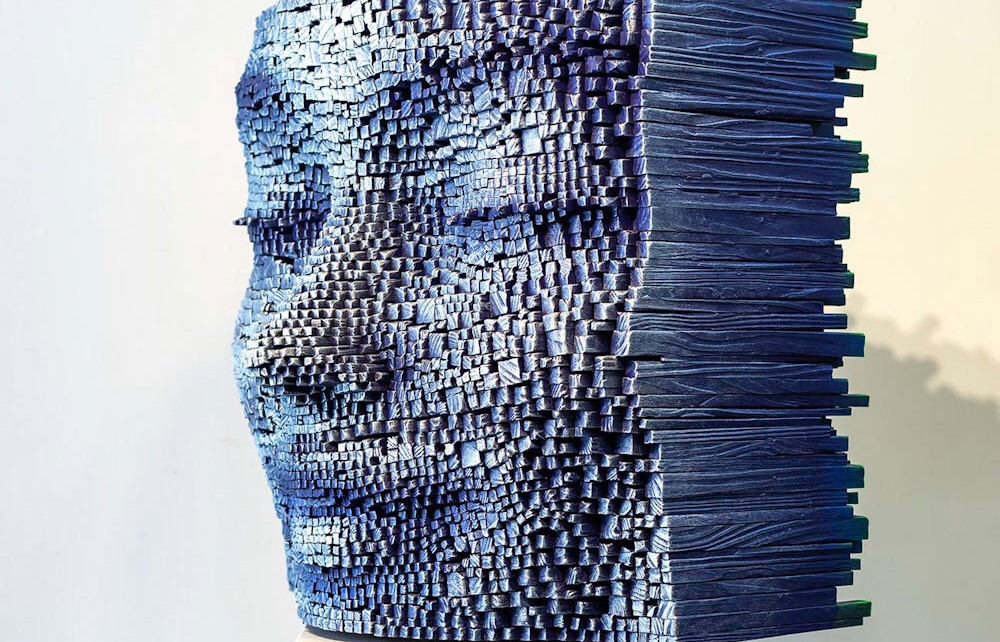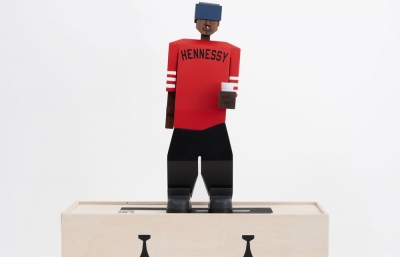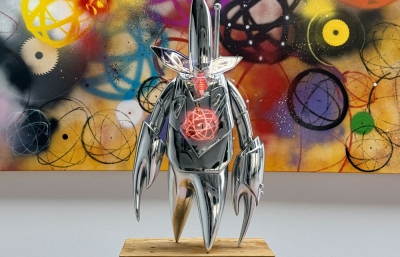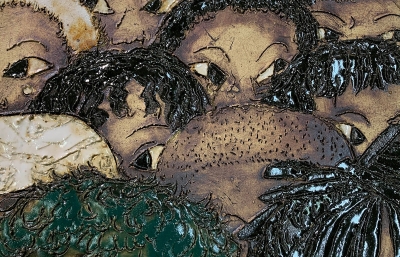Continuing in his Bending the Lines series, Gil Bruvel will be exhibiting a selection of artwork with Chloe Fine Arts at the Art Market San Francisco April 25 – 28th, 2019. To some give insight to the creative process that makes Gil Bruvel accessible, Pat Green, a three-time Grammy-nominated Texas musician and close friend to Gil joined him for lunch and an interview at Bruvel’s home.
Continuing in his Bending the Lines series, Gil Bruvel will be exhibiting a selection of artwork with Chloe Fine Arts at the Art Market San Francisco April 25 – 28th, 2019. To some give insight to the creative process that makes Gil Bruvel accessible, Pat Green, a three-time Grammy-nominated Texas musician and close friend to Gil joined him for lunch and an interview at Bruvel’s home.
Pat Green: In twenty-five years of music I go through certain times where I focus on different things, and as a friend and fan of your art, Gil, what I notice is that when you work with lines you seem to have a very clear thought of what you have to accomplish, contrasted to when you are painting, on a figurative level. When you're making the Flow series, with your sculpture, do you feel like Bending the Lines is related or do you feel like they are completely different?
Gil Bruvel: I think that it is related. The reason why I call it the Bending the Lines series stems from the idea of the metaphysical flow. Fluid dynamic flow, physical flow, elemental from erosion and all of that to the meditative. Basically, the idea is that I can take rigid sticks, put them together, and they begin to move together fluidly; a continuity from the Flow series that takes shape within a new medium. I focus not only on the frontal views but on the sides as well so they become sculptural from multiple angles.
I want to interject and say, you mentioned the meditative state. I want to know, when you are creating, either within the flow or with paint, or whatever medium you are using, do you meditate? Is the meditative state something you use as a catalyst to bring more out of yourself or is it really just performed?
I think that the act of creating the piece or conceptualizing the piece (and I know it seems all cliché) but it’s the element of where you have to get into the zone.
So both meditative and spur of the moment?
Well, meditative does not mean it is a rigid process. It is a fluid process.

What is your source material? Is that a sketch? What is the base?
Basically, the base is super low tech, whether it is for the wall sculpture or the faces. I do not sketch anything to do the three-dimensional faces, I sketch some basic lines to do the wall sculptures. I already have a visualization of it. Even though I may improvise with the pattern, I have the overall flow line that I need. So that is what I trace. Then when I come back and put the sticks together, one after the other, then that’s where I will improvise with the pitch and the curve and the tilt or whatever. That’s where the meditative part comes into it, you know when I improvise with the ways the sticks overlap and relate to each other. That’s where the Zen part of [my process] is, because I get really into it and time disappears. It is fun to do because you see the artwork appearing in front of you.
I have been around your work for more than a decade now. Tell me the comparative evolution between the Flow and the Bending the Lines series. What I had enjoyed in the workshop today is not what I saw of Bending the Lines a year ago. Describe to me what it feels like to you personally when a line of your work goes from one place to another. Is it gratifying, is it scary?
Well, to me, it is not about seeking anything else than the initial idea I have and to express it as correctly as possible. The Flow series was about creating artwork that related to the flow of nature, related to physical sensations. I would equate the feeling of wind pushing against our skin with a visual pattern that you can find in nature through the movement of the wind blowing through the tree canopies, or creating a pattern on the sand. The same thing can apply to Bending the Lines. The difference however between the two is that the Flow series was related to our identity as human beings. The human body, in the forms of busts and portraits, things like that. The Bending the Lines walls sculptures that followed are about abstracted translations of those ideas. Then the Bending the Lines faces went back to “Who are we and what is our identity?” On one side you have these pixelated faces made out of thousands of sticks, then they were burned, which is also a way to express the ephemeral nature of humanity. We have a shelf life. In the back, it is like a neural pathway of emotions from the meditative faces that is then carried on by the shapes and colors that represent these feelings. The two separate series reflect human nature.
As a musician, I have learned what pleases the ear. It has brought great joy to my life, singing to people and having them respond back to me with all of the stuff that comes back to me with my job. I look at Bending the Lines and it is the greatest piece of eye-candy that I have seen. Not only that, you can’t take it all in at one and you can’t take it in from one angle. What is it about three-dimensional art that just gets you going?
What I think I like to do is combine my interest in form, shapes, and volume as well as the decades I have spent creating paintings. I can combined colors with volume.

What I have noticed is that, depending on the lighting, there is a dramatic impact on the color palette of the artwork. Tell me about that.
That’s the adventure of this volume. You move around the piece and it changes. Of course, the colors react differently to the light as you move around it.
I have one in my gallery that if you stand on the left side of it, there is a beautiful white color and if you stand on the right side of it, there is an amazing combination of green and orange. I.. don’t even have a question, thank you for that. (Both chuckle)
I can tell you the question and the answer, in this case, what relates to that for me. The eye-candy part, as a musician, you, of course, are attuned to sound more than anything else. There is an incorporation of that in my artwork. To me, the volume and the colors correspond to sound. This relates to the eye-candy effect, you know. It is a combination, multi-layering of the senses.
So tell me, what’s next? Where do you go from here? Is there innumerable directions that you can go with this series, or do you feel like you’re kind of getting tired of it?
No, and actually, there is a new direction I am experimenting right now with some prototypes. I am going to continue to extend the upper part of the faces with vertical, architectural forms in ways. So that is a part that really excites me. I can continue to explore and I am fortunate enough that my public is following and supporting my effort to continue creating.
I notice that the facial expressions on your artworks are changing and I start to feel different because I have seen this series from start to finish. How do you to elicit an emotional response?
I am not thinking about the potential emotional response. I am thinking about what I felt at a given moment.

How does music influence your artwork?
Music influence my artwork all the time. I grew up in a family of musicians and I always felt that it is not only complementary but essential to my work. The synesthesia that I have is the overlapping of senses. Tasting color, seeing music, these things knowingly played a part in my creative process.
Is there a medium that you haven’t work with that you are curious about?
Right now, with this new experimentation, I am going to combine bronze and wood as well as aluminum wood. I will also be doing some sand casting, and incorporate that with the sticks. I am looking forward to it.
At what point do you think your wall art will be too heavy for the walls? (Chuckles)
You just build stronger walls. I manage, so far I haven’t had any problems.
I think the ultimate expression for an artist is to follow your heart, the vision. Following the stimulation that is felt within life.
Describe to me your favorite part of the human condition.
That would be the imperfections that we all carry, and our acceptance of it.
When you wanted and expected the most out of yourself, when did you let yourself down as an artist?
Failure, as an artist, is absolutely essential to the creative process. My expectation is to maintain the intensity of the original sensation along the creative process. I let myself down if I do not keep this intensity.

What part of your life makes you want to work with wood now?
Wood as a medium is basically a part of my childhood. With my father being a cabinet worker, I grew up in his workshop. The main part of working with wood for me now is that woods contains its own flow, you can see where it marks itself throughout the years of growth. Everything that the tree had gone through in life can be seen within the grooves. When I burn the surface of it, you accentuate the unique patterns contained in every piece of wood. That is what has inspired me, I look at the wood and allow it to influence my process.
This is a particular question and I want you to answer it honestly. Describe to me, if and when the public comes into making this series. Are you thinking about what they want or are you making art for yourself?
I don’t want to sound selfish but yeah, I am making art for myself.
I have known you for so long now, you are apart of my family, apart of my life and as a person who works with words it is still difficult for me to describe. What is the most gratifying part of being a lifelong artist?
You do what you love the most every day. You connect with people that you never would have connected with otherwise. It is the ultimate universal language, not only doing what you love but you embrace the world and people embrace you.










